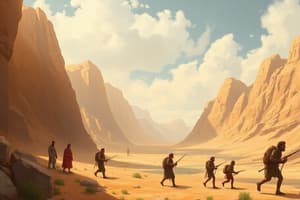Podcast
Questions and Answers
What was one main use of tools by hunter-gatherers?
What was one main use of tools by hunter-gatherers?
- To hunt large animals (correct)
- To travel long distances
- To make cave drawings
- To pick wild vegetation
Which natural disaster is believed to have prompted early humans to migrate out of Africa?
Which natural disaster is believed to have prompted early humans to migrate out of Africa?
- A heat wave
- Widespread flooding
- Extreme drought (correct)
- An earthquake
Which continent did early humans reach using a now nonexistent land bridge?
Which continent did early humans reach using a now nonexistent land bridge?
- Australia
- Asia
- Europe
- North America (correct)
What does the existence of Paleolithic cave paintings indicate about early human life?
What does the existence of Paleolithic cave paintings indicate about early human life?
Where did the first permanent human settlements predominantly form?
Where did the first permanent human settlements predominantly form?
Why were early humans able to find crops growing in their camps?
Why were early humans able to find crops growing in their camps?
What was one significant effect of settling in one place during the Neolithic period?
What was one significant effect of settling in one place during the Neolithic period?
How can the changes that occurred during the Neolithic period be best characterized?
How can the changes that occurred during the Neolithic period be best characterized?
What did people transition from during the development of agriculture?
What did people transition from during the development of agriculture?
Which two developments occurred during the Neolithic period?
Which two developments occurred during the Neolithic period?
Which geographic feature was essential for the growth of wild grains?
Which geographic feature was essential for the growth of wild grains?
Which event occurred first in the evolution of early societies?
Which event occurred first in the evolution of early societies?
What effect did the domestication of animals have on human societies?
What effect did the domestication of animals have on human societies?
What typically happened when farmers produced more crops than they could consume?
What typically happened when farmers produced more crops than they could consume?
What conclusion can be drawn about Neolithic people who created pottery?
What conclusion can be drawn about Neolithic people who created pottery?
Which characteristic was NOT developed during the Neolithic revolution?
Which characteristic was NOT developed during the Neolithic revolution?
What was most likely included in the regular diet of the earliest hunter-gatherers?
What was most likely included in the regular diet of the earliest hunter-gatherers?
What climate condition is believed to have influenced the migration of the earliest humans?
What climate condition is believed to have influenced the migration of the earliest humans?
What significant event occurred approximately sixty to ninety thousand years ago?
What significant event occurred approximately sixty to ninety thousand years ago?
Where did the first humans predominantly live?
Where did the first humans predominantly live?
Which factor was essential in enabling early humans to collaborate and address challenges?
Which factor was essential in enabling early humans to collaborate and address challenges?
What was a primary reason for the nomadic lifestyle of human hunter-gatherers?
What was a primary reason for the nomadic lifestyle of human hunter-gatherers?
What role did wild plants play in the diet of early humans?
What role did wild plants play in the diet of early humans?
Which of the following does not represent a reason for early humans' migration?
Which of the following does not represent a reason for early humans' migration?
Which of the following are characteristics of civilizations? Select the three correct answers.
Which of the following are characteristics of civilizations? Select the three correct answers.
What conclusion can be made about the people of Mesopotamia based on the image of cuneiform?
What conclusion can be made about the people of Mesopotamia based on the image of cuneiform?
Why do civilizations need a form of communication?
Why do civilizations need a form of communication?
What conclusion can be made about the Mesopotamian civilization based on the figure of a person playing a harp?
What conclusion can be made about the Mesopotamian civilization based on the figure of a person playing a harp?
Why was it important for humans to domesticate plants?
Why was it important for humans to domesticate plants?
What geographical feature was common to the earliest civilizations?
What geographical feature was common to the earliest civilizations?
What makes early civilizations unique compared to those that followed later?
What makes early civilizations unique compared to those that followed later?
How did early civilizations control floodwaters?
How did early civilizations control floodwaters?
Flashcards
Early human diet
Early human diet
The primary food source of early hunter-gatherers was wild plants and small animals.
Paleolithic migration cause
Paleolithic migration cause
Climate change, specifically ice ages, prompted early humans to migrate.
Human migration time period
Human migration time period
Between 60,000 and 90,000 years ago, humans began migrating away from Africa.
First humans' origin
First humans' origin
Signup and view all the flashcards
Early human problem-solving
Early human problem-solving
Signup and view all the flashcards
Nomadic hunter-gatherers
Nomadic hunter-gatherers
Signup and view all the flashcards
Earliest human origin location
Earliest human origin location
Signup and view all the flashcards
Early human cooperation
Early human cooperation
Signup and view all the flashcards
Hunter-gatherer tools
Hunter-gatherer tools
Signup and view all the flashcards
First human migration cause
First human migration cause
Signup and view all the flashcards
Land bridge migration
Land bridge migration
Signup and view all the flashcards
Paleolithic cave paintings
Paleolithic cave paintings
Signup and view all the flashcards
Nomadic lifestyle
Nomadic lifestyle
Signup and view all the flashcards
First permanent settlements
First permanent settlements
Signup and view all the flashcards
Early agriculture and settlements
Early agriculture and settlements
Signup and view all the flashcards
Neolithic period changes
Neolithic period changes
Signup and view all the flashcards
Neolithic Revolution
Neolithic Revolution
Signup and view all the flashcards
Surplus
Surplus
Signup and view all the flashcards
Specialization
Specialization
Signup and view all the flashcards
Domestication
Domestication
Signup and view all the flashcards
What led to the development of agriculture?
What led to the development of agriculture?
Signup and view all the flashcards
Effects of animal domestication?
Effects of animal domestication?
Signup and view all the flashcards
What was the impact of surplus?
What was the impact of surplus?
Signup and view all the flashcards
Neolithic pottery and art?
Neolithic pottery and art?
Signup and view all the flashcards
Civilization traits
Civilization traits
Signup and view all the flashcards
Cuneiform reveals what?
Cuneiform reveals what?
Signup and view all the flashcards
Civilization communication purpose
Civilization communication purpose
Signup and view all the flashcards
Mesopotamian harp implies?
Mesopotamian harp implies?
Signup and view all the flashcards
Plant domestication importance
Plant domestication importance
Signup and view all the flashcards
Common feature of early civilizations
Common feature of early civilizations
Signup and view all the flashcards
What makes early civs unique?
What makes early civs unique?
Signup and view all the flashcards
How did early civilizations manage floods?
How did early civilizations manage floods?
Signup and view all the flashcards
Study Notes
Assessment: Chapter 1—“Early Humans and the Paleolithic World"
-
Earliest Hunter-Gatherer Diet: The two most likely components of the earliest hunter-gatherer diet were small animals and wild plants.
-
Paleolithic Period Migration: Scientists believe climate changes, specifically ice ages, prompted early humans to migrate.
-
Sixty to Ninety Thousand Years Ago: Events from this period include early human migration out of Africa.
-
First Human Settlements: Mesopotamia was a location for the first permanent human settlements.
Assessment: Chapter 2—“The Agricultural Revolution”
-
First Permanent Settlements: The first permanent human settlements emerged in Mesopotamia.
-
Crop Growth in Camps: Early humans returned to camps and found crops growing, likely due to seeds they dropped from previous seasons.
-
Neolithic Period: This period lasted from 10,000 BCE to 3000 BCE, showcasing significant shifts in human lifestyles.
-
Neolithic Period Changes: Characterized by the shift from nomadic to settled agricultural societies, with advancements like civilization development, language, and agriculture.
-
Neolithic Period Developments: Important developments included large settlements, migration across continents, bartering and trade, sophisticated tools, and architectural advancements.
Assessment: Chapter 3—“The Characteristics of Civilization”
-
Characteristics of Civilizations: Three of the critical characteristics of a civilization include; infrastructure, division of labor, and organized government.
-
Mesopotamian Image Conclusion: The provided imagery suggests a shared language among the Mesopotamian people.
-
Evolution of Communication: Early civilizations needed communication to support their collective actions, solve problems and conduct their everyday affairs.
-
Mesopotamian Figure: The harp-playing figure suggests distinct social classes existed in Mesopotamian society.
-
Importance of Plant Domestication: Domestication of plants was crucial for a stable food supply.
-
Geographical Feature for Early Civilizations: Nearby rivers and flood plains were common features in the early civilizations, as they provided crucial resources for agriculture.
-
Early Civilizations Unique Characteristics: In contrast to later civilizations, Early civilizations typically lacked a blueprint or model to follow.
-
Early Flood Control Methods: Evidence suggests early civilizations employed dams, canals, and seasonal migration/planning to control floodwaters.
-
Technological Advancements for Agriculture: The pottery wheel was an important technological advancement that enabled larger-scale agricultural methods.
-
Early Writing Forms: Early forms of writing, like the example of land records, suggest the development of property ownership and social organization.
-
Key Characteristic of Civilization in Fertile Crescent: The most important characteristic for the development of civilization in the Fertile Crescent is likely the development of agriculture, supported by reliable water sources, that underpinned the entire lifestyle of the population.
Studying That Suits You
Use AI to generate personalized quizzes and flashcards to suit your learning preferences.




